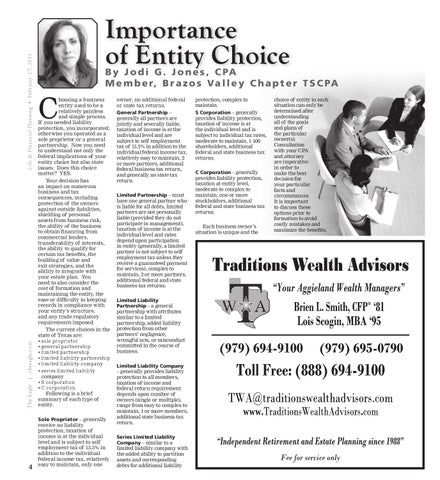Life & Financial Planning • February 27, 2011 The Eagle | theeagle.com
4
Importance of Entity Choice
B y J o d i G . J o n e s , C PA M e m b e r, B r a z o s Va l l e y C h a p t e r T S C PA
C
hoosing a business entity used to be a relatively painless and simple process. If you needed liability protection, you incorporated; otherwise you operated as a sole proprietor or a general partnership. Now you need to understand not only the federal implications of your entity choice but also state issues. Does this choice matter? YES. Your decision has an impact on numerous business and tax consequences, including protection of the owners against outside liabilities, shielding of personal assets from business risk, the ability of the business to obtain financing from commercial lenders, transferability of interests, the ability to qualify for certain tax benefits, the building of value and exit strategies, and the ability to integrate with your estate plan. You need to also consider the cost of formation and maintaining the entity, the ease or difficulty in keeping records in compliance with your entity’s structure, and any trade regulatory requirements imposed. The current choices in the state of Texas are: • sole proprietor • general partnership • limited partnership • limited liability partnership • limited liability company • series limited liability company • S corporation • C corporation. Following is a brief summary of each type of entity. Sole Proprietor – generally receive no liability protection, taxation of income is at the individual level and is subject to self employment tax of 15.3% in addition to the individual federal income tax, relatively easy to maintain, only one
owner, no additional federal or state tax returns. General Partnership – generally all partners are jointly and severally liable, taxation of income is at the individual level and are subject to self employment tax of 15.3% in addition to the individual federal income tax, relatively easy to maintain, 2 or more partners, additional federal business tax return, and generally no state tax return. Limited Partnership – must have one general partner who is liable for all debts, limited partners are not personally liable (provided they do not participate in management), taxation of income is at the individual level and rates depend upon participation in entity (generally, a limited partner is not subject to self employment tax unless they receive a guaranteed payment for services), complex to maintain, 2 or more partners, additional federal and state business tax returns. Limited Liability Partnership – a general partnership with attributes similar to a limited partnership, added liability protection from other partners’ negligence, wrongful acts, or misconduct committed in the course of business. Limited Liability Company – generally provides liability protection to all members, taxation of income and federal return requirement depends upon number of owners (single or multiple), range from easy to complex to maintain, 1 or more members, additional state business tax return. Series Limited Liability Company – similar to a limited liability company with the added ability to partition assets and corresponding debts for additional liability
protection, complex to maintain. S Corporation – generally provides liability protection, taxation of income is at the individual level and is subject to individual tax rates, moderate to maintain, 1-100 shareholders, additional federal and state business tax returns. C Corporation – generally provides liability protection, taxation at entity level, moderate to complex to maintain, one or more stockholders, additional federal and state business tax returns. Each business owner’s situation is unique and the
choice of entity in each situation can only be determined after understanding all of the goals and plans of the particular owner(s). Consultation with your CPA and attorney are imperative in order to make the best decision for your particular facts and circumstances. It is important to discuss these options prior to formation to avoid costly mistakes and maximize the benefits.
